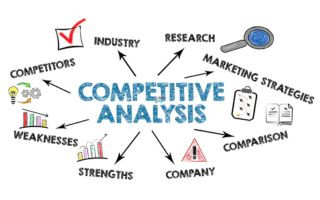In today's highly competitive market, understanding your competitors' strategies is crucial for refining your own marketing approach. By analyzing competitor strategies, businesses can gain valuable insights that help in identifying opportunities, anticipating market trends, and improving their own marketing tactics. This blog will guide you through effective methods to analyze competitor strategies and leverage this knowledge for better marketing outcomes.
Why Analyze Competitor Strategies?
Analyzing competitor strategies provides several benefits:
Identify Market Trends: Understanding what competitors are doing helps you stay informed about market trends and shifts in consumer preferences.
Discover Opportunities: By identifying gaps in competitors' strategies, you can uncover new opportunities to differentiate your brand and address unmet needs.
Enhance Your Own Strategies: Insights gained from competitors can be used to refine your own marketing tactics, ensuring that your approach is effective and competitive.
Improve Positioning: Analyzing competitors allows you to assess your brand’s positioning relative to others, helping you to refine your unique selling propositions (USPs) and value propositions.
Steps to Analyze Competitor Strategies
1. Identify Your Competitors
Start by identifying your direct and indirect competitors. Direct competitors offer similar products or services in the same market, while indirect competitors may offer alternatives or substitute products.
- Direct Competitors: Those who offer the same products or services and target the same customer base.
- Indirect Competitors: Those who provide alternative solutions to the same problem or fulfill similar customer needs.
2. Gather Data on Competitor Marketing Activities
Collect data on your competitors' marketing strategies through various sources:
- Website Analysis: Review competitors' websites for information on their product offerings, messaging, pricing, and overall user experience.
- Social Media: Monitor competitors' social media profiles for insights into their content strategy, engagement levels, and audience interactions.
- Advertising Campaigns: Analyze their online and offline advertising efforts, including digital ads, print media, and promotional campaigns.
- Public Relations: Look at press releases, media coverage, and other PR activities to understand how competitors are positioning themselves in the market.
3. Analyze Competitor Content
Evaluate the type and quality of content competitors produce:
- Content Topics: Identify the topics and themes that competitors focus on. This can reveal their target audience's interests and the gaps they are addressing.
- Content Formats: Assess the formats used, such as blogs, videos, infographics, or podcasts, and how these formats resonate with their audience.
- Engagement Metrics: Look at metrics like likes, shares, comments, and views to gauge the effectiveness of their content and engagement strategies.
4. Evaluate Competitor Strengths and Weaknesses
Assess the strengths and weaknesses of your competitors:
- Strengths: Identify areas where competitors excel, such as customer service, product features, or brand reputation.
- Weaknesses: Look for areas where competitors fall short, such as poor customer reviews, gaps in product offerings, or ineffective marketing tactics.
5. Analyze Competitor Pricing and Promotions
Understanding competitors' pricing strategies and promotional tactics can provide insights into market positioning and consumer behavior:
- Pricing Models: Compare pricing structures and value propositions to understand how competitors position themselves in terms of cost and value.
- Promotions and Discounts: Review any ongoing promotions, discounts, or special offers to see how competitors attract and retain customers.
6. Monitor Competitor Customer Feedback
Customer feedback and reviews can offer valuable insights into competitors’ strengths and areas for improvement:
- Online Reviews: Check platforms like Google Reviews, Yelp, or Trustpilot for customer opinions and feedback on competitors' products and services.
- Social Media Mentions: Monitor social media for mentions of competitors, paying attention to customer sentiment and common complaints.
7. Benchmark Competitor Performance
Use key performance indicators (KPIs) to benchmark competitors’ performance:
- Website Traffic: Tools like Google Analytics or SimilarWeb can provide data on competitors' website traffic and audience demographics.
- Social Media Metrics: Platforms like Sprout Social or Hootsuite offer insights into competitors' social media performance, including follower growth and engagement rates.
8. Use Competitive Intelligence Tools
Leverage competitive intelligence tools to gather and analyze data more efficiently:
- SEMrush or Ahrefs: These tools provide insights into competitors' SEO strategies, including keywords, backlinks, and site performance.
- BuzzSumo: Use BuzzSumo to analyze competitors' top-performing content and influencer partnerships.
- SpyFu: This tool offers insights into competitors' paid search strategies and keywords.
Turning Insights into Action
Once you have gathered and analyzed data, it’s important to apply these insights to your own marketing strategies:
Refine Your Unique Selling Proposition (USP): Use the information to sharpen your USP, ensuring it highlights your strengths and differentiates you from competitors.
Enhance Your Content Strategy: Based on competitors' content performance, adjust your content strategy to better address audience needs and preferences.
Optimize Your Pricing Strategy: If competitors are offering similar products at different price points, consider how you can adjust your pricing or add value to stand out.
Improve Customer Experience: Use insights into competitors' customer service and feedback to enhance your own customer experience and address any weaknesses.
Innovate and Differentiate: Leverage identified gaps in competitors' strategies to innovate and offer unique solutions that meet customer needs more effectively.
Conclusion
Analyzing competitor strategies is an essential component of a successful marketing strategy. By understanding what your competitors are doing, you can identify opportunities for improvement, stay ahead of market trends, and refine your approach to better meet your customers' needs. Use the insights gained from competitor analysis to enhance your marketing efforts, drive growth, and achieve a competitive edge in your industry


